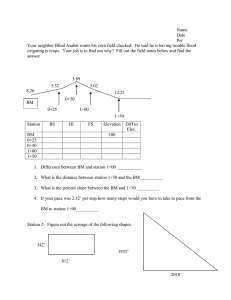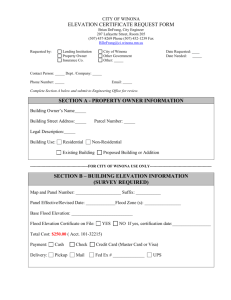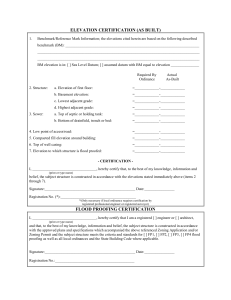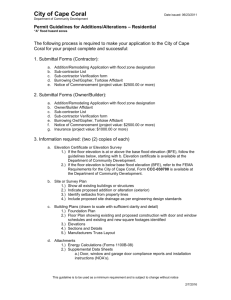Elevating a Structure - Southern Tier Central Regional Planning and
advertisement
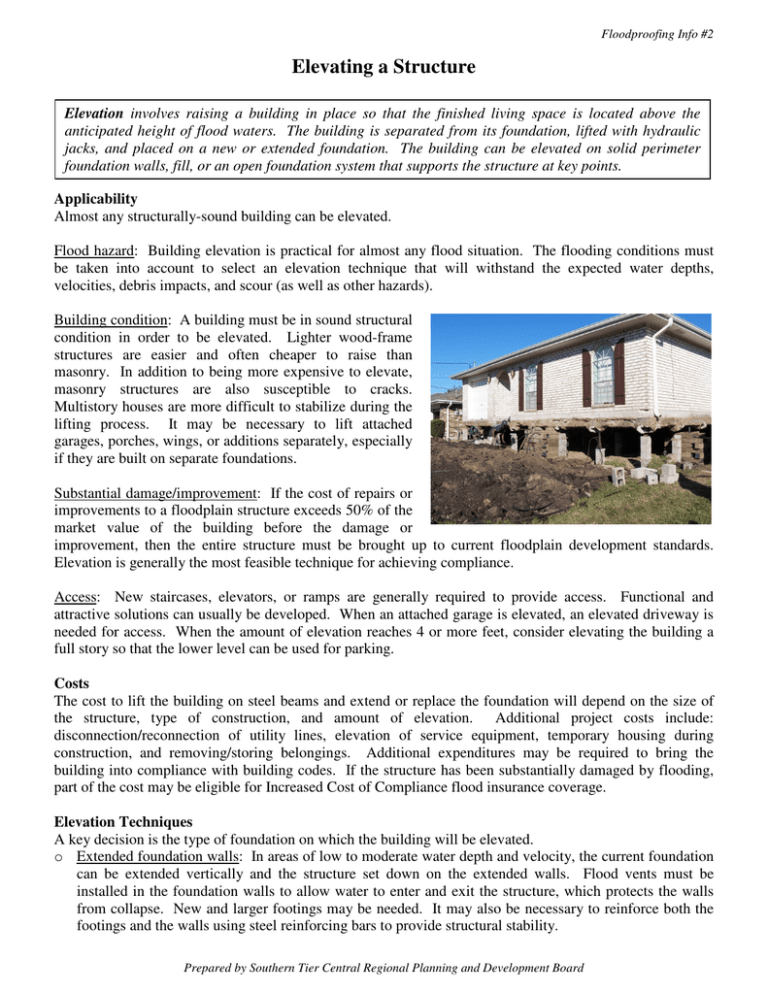
Floodproofing Info #2 Elevating a Structure Elevation involves raising a building in place so that the finished living space is located above the anticipated height of flood waters. The building is separated from its foundation, lifted with hydraulic jacks, and placed on a new or extended foundation. The building can be elevated on solid perimeter foundation walls, fill, or an open foundation system that supports the structure at key points. Applicability Almost any structurally-sound building can be elevated. Flood hazard: Building elevation is practical for almost any flood situation. The flooding conditions must be taken into account to select an elevation technique that will withstand the expected water depths, velocities, debris impacts, and scour (as well as other hazards). Building condition: A building must be in sound structural condition in order to be elevated. Lighter wood-frame structures are easier and often cheaper to raise than masonry. In addition to being more expensive to elevate, masonry structures are also susceptible to cracks. Multistory houses are more difficult to stabilize during the lifting process. It may be necessary to lift attached garages, porches, wings, or additions separately, especially if they are built on separate foundations. Substantial damage/improvement: If the cost of repairs or improvements to a floodplain structure exceeds 50% of the market value of the building before the damage or improvement, then the entire structure must be brought up to current floodplain development standards. Elevation is generally the most feasible technique for achieving compliance. Access: New staircases, elevators, or ramps are generally required to provide access. Functional and attractive solutions can usually be developed. When an attached garage is elevated, an elevated driveway is needed for access. When the amount of elevation reaches 4 or more feet, consider elevating the building a full story so that the lower level can be used for parking. Costs The cost to lift the building on steel beams and extend or replace the foundation will depend on the size of the structure, type of construction, and amount of elevation. Additional project costs include: disconnection/reconnection of utility lines, elevation of service equipment, temporary housing during construction, and removing/storing belongings. Additional expenditures may be required to bring the building into compliance with building codes. If the structure has been substantially damaged by flooding, part of the cost may be eligible for Increased Cost of Compliance flood insurance coverage. Elevation Techniques A key decision is the type of foundation on which the building will be elevated. o Extended foundation walls: In areas of low to moderate water depth and velocity, the current foundation can be extended vertically and the structure set down on the extended walls. Flood vents must be installed in the foundation walls to allow water to enter and exit the structure, which protects the walls from collapse. New and larger footings may be needed. It may also be necessary to reinforce both the footings and the walls using steel reinforcing bars to provide structural stability. Prepared by Southern Tier Central Regional Planning and Development Board Floodproofing Info #2 o Abandoning the lower enclosed area: An alternative for a masonry building on a slab-on-grade foundation is to abandon the existing lower enclosed area and convert it to a flood-prone area below the first floor that is used only for parking, storage, and building access. An existing upper floor can be used for living space. For a one-story building, the roof and roof framing can be removed to build a new second story living area. o Fill: In order to elevate an existing building on fill, the structure must be temporarily relocated while fill is brought in and compacted. o Open foundation: Elevating a building on an open foundation involves raising it onto piers, posts (columns), or piles and allowing water to flow beneath the building. The foundation type depends on the flood and site characteristics. Piers are designed primarily for vertical loading and are thus most appropriate for shallow depth and low velocity flood conditions where they will not be subjected to significant horizontal forces. Posts and columns are generally cross braced for added stability and can be used when the anticipated flood conditions involve moderate depths and velocities. Piles (which are driven or jetted deep into the ground) are less susceptible to the effects of high-velocity floodwaters, scouring, and debris impact and are often used to elevate coastal buildings. Advantages and Disadvantages of Elevation Advantages Disadvantages • Elevation to the required flood protection level allows a substantially damaged or improved structure to be brought into compliance with floodplain development standards. • Elevation can significantly reduce flood risks to the structure and its contents. • Except where the area below the structure is used for storage, elevation does not require active intervention during a flood (such as relocation of vulnerable items to higher levels). • Often reduces flood insurance premiums. (In the regulated floodplain, actuarial insurance costs are based on the height of the first floor relative to the Base Flood Elevation.) • Techniques are well-known and qualified contractors are often readily available. • Does not require that additional land beyond the original footprint of the structure. • Cost may be prohibitive. • Elevation may significantly alter the appearance of the structure. • The structure should not be occupied during a flood. • Additional stairs and/or an elevator may be required to access the structure. • Special measures must be taken if the structure will be subject to high-velocity water flow, fast-moving ice or debris flow, or erosion. • Additional costs may be incurred to bring the structure into compliance with current building codes for plumbing, electrical, and energy systems. • Forces due to wind and seismic hazards must be considered. Additional Information o Above the Flood: Elevating Your Floodprone House, FEMA 347 (2000), http://www.fema.gov/library/viewRecord.do?id=1424. Prepared by Southern Tier Central Regional Planning and Development Board



